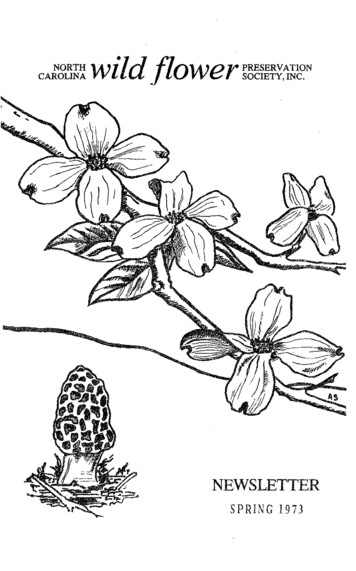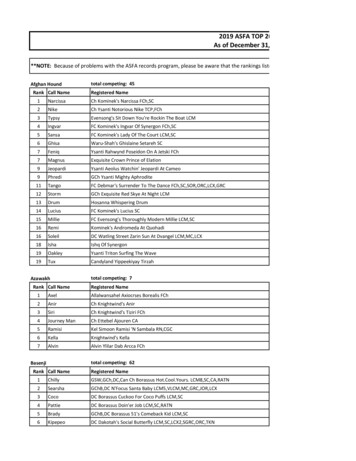
Transcription
.NEWSLETTERSPRING1973
NORTH CAROLINA WILD FLOWERPRESERVATIONSOCIETY.INCORPORATEDMr. Thomas Shinn, PresidentRoute 1, Box 321-ALeicester,N. C. 28748Dr. B. W. wells, ConsultantRoute 1Wake Forest, N. C. 27587Mrs. Pearson Stewart,Vice President &112 Glendale DriveDirectorChapel Hill, N. C. 27408Dr. H. R. Totten, ConsultantP. O. Box 247Chapel Hill, N. C. 27514Mrs. Richard Donnan,Rec.Box 88'5Chapel Hill, N. C. 27514W. Gordon Butler, COTlsul(cwt & Dir.Route 7, Box 318-ASec.Fayetteville,N. C. 28306J.Mrs. Carl H. Pegg, Ht storian . L ibrarian403 Laurel HilI RoadChapel Hill, N. C. 27514Dr.Miss Bessie Pope, TreasurerP. O. Box 1264High Point. N. C. 27261Mrs. W. T. Lamm, Jr.,903 Raleigh RoadWilson, N. C. 27893Miss Nancy Julian, Carr. Sec.1933 Gaston StreetWinston Salem, N. C. 27103Dr. Herbert Heckenbleikner,1000 Carmel RoadCharlotte,N. C. 28211Mrs. H. R. Totten, By-Lau/sLaurel Hill RoadChapel Hill, N. C. 27514Mrs. Walter Braxton, Director2111 Braxton LaneGreensboro,N. C. 27408P. Tyndall, ConsultantRoadWilson, N. C. 27893314 CanterburyChrnn.Mrs. E. Gregory Lewis, Publirity907 Greenwood DriveGreenshoro,N. C. tDir.& DirectorBox 313PleasantGarden,STAPPMercer Reeves Hubbard, Editor2000 Cedar Street, Durham, N. C. 27706Linda Mitchell Lamm, Co-Editor903 Raleigh Road, Wilson, N, C. 27893Nancy Clark Stronach, Art EditorP. O. Box 1059, Wilson, N. C. 27893Mary Gilliam Clark607 Raleigh Road, WlIsoo, N. C. 27893N, C. 27313
PRESIDENT'SMESSAGE0, Wind,If Winter comes, can Spring be far behind?ShelleySpring is almost with us again. Buds which havebeen asleep all winter are opening up. Early perennialsare beginning to bloom, and others are giving promiseof more blossoms during the coming weeks.Nature isbeginning to reawaken.Flower beds should by now beabout ready for planting, heavy mulch should all beremoved from perennials, and preparations being madefor starting soft-wood cuttings.All of those seedwhich were saved from last year's flowers should beeither in the ground or ready to be planted.****************A recent issue of one of the publications of TheAmerican Horticultural Society printed the followingvariation of 'Keep Off the Grass', taken from Cardigan Mountain School, Canaan, New Hampshire:"If this grass is allowed to grow, it willprovide oxygen for two boys for one semester".Grass, flowers, and trees are essential elementsin our ecology.Each leaf does its small share ofcontrolling noise, modifying our climate, and helpingto furnish the oxygen which is so necessary to ourvery existence.Thomas ShinnFor, lo! The winter is past, the rain is overand gone; the flowers appear on the earth; thetime of the singing of birds is corne, and thevoice of the turtle is heard in our land.The Song of Solomon113
U5-27&o5 - -1s ",r:3; &',A7 s: te. I1'11,'J
SPRING MEETINGThe Spring MeetingMay 19th and 20th.will be held at Brevard,N. C. onThe first gathering will be on Saturday afternoon atBerry's Restaurant (See map) at 2 PM for a trip to thefarm of Mr. Moore - about two miles distant - where hehas added to the natural growth of wildflowers.At 6:30 PM Saturday there will be a dinner meeting buffet style - at Berry's, followed by a short businesssession and a slide program for entertainment.The costof the meal will be 2.75 per person.This includes bothtax and gratuities.It will be necessary to make yourreservations for dinner through Mr. Charles F. Moore,p. O. Box 8, Brevard, N. C. 28712. No deposit necessary.Sunday morning at 8:30 we meet at Berry's for a tourof 'The Cradle of Forestry in America'.This is locatedat the Pink Beds, on US-276, about nine miles from thereference point on the map (Jet. US-64;US-276;NC-280).This tour should be over about noon, but there areother parking areas along the route with hiking trailsleading from each, there are waterfalls, a fish hatchery,and many other points of interest.For those who would likea picnic lunch on the mountain, orders will be taken atthe Saturday night meeting.Berry's offers a chickenbox lunch, with all trimmings, for 1.75, or sandwichesmay be ordered from the menu.Thermos bottles may befilled with coffee at the restaurant. and other drinksmay be purchased there or on the way.We are advised that, because of local traffic onweek-ends that Sunday is not the day for a visit to theShortia territory; however, those who are interested maystay over until Monday, and a trip to that area will bearranged - provided that water has not covered everything by that time.This is important.Make your motel reservations assoon as you get this notice.This point has been stressedby each of the motels contacted.They are all rathersmall, and the demand for rooms increases as the weatherbegins to get warm enough for people to enjoy a week-endin the mountains.BE SURE TO WEAR YOUR NAMEPLATES.5
ACCOMMODATIONSIN BREVARD1 Double1 PArsonBed2 Persons2 Double Beds2 PersonsImperial Motor Lodge10.0012.0014.00Brevard Motor .00Sunset MotelCafe nearbyColonial Inn MotelDining RoomForest Gate MotelHWYS. 64 & 276 & 280Cafe nearbyFor each additionalperson in a room the charge is 2.00.The mailing address for Forest Gate Motel is Pisgah Forest,N. C. 28768. All others are Brevard, N. C. 28712.Some of the rooms at Imperial, Colonial, and probablyBrevard, are on second floor. Steps at Colonial arerather steep. Keep this in mind when making reservations.Also be sure to state that you are to attend the wildflower meeting.***************THE CRADLE OF FORESTRYIN AMERICAThe first school of forestry in this country wasestablished on the Biltmore Estate in 1898 under thedirection of George Vanderbilt and conducted by Dr.Carl A. Schenck, who had been brought from Germanyto manage the estate. He was the successor toGifford Pinchot, who later became Governor of Pennsysvania. Buildings and other relics of this schoolhave been preserved and are now on display.6
MINUTESOF THE FALL MEETING October8, 1972The NCWPS met in the Civic Center in Hope Mills,North Carolina, on Sunday, October 8, 1972.A picnic lunch was enjoyed from twelve to one p.m.At one the business meeting was called to order bythe president, Tom Shinn.The treasurer, Miss Bessie Pope, reported 349.07on hand. She requested that members check their membership cards to see if they are paid through May1973. If not, please pay 2.00 dues.Mr. Shinn urged our members to live up to ourname as a Preservation Society and encourage andpractice the propagation of native plants.He recommended two booklets which dealt with plant propagation.Handbook #24 Propogation, published by BrooklynBotanic Garden, 1000 Washington Ave., Brooklyn, N.Y.02130.Cost 1.25.Arnoldia July 1972 published by Arnold Arboretum,Jamaica Plain, article "A Simple Frame for SoftwoodPropagation" by Alfred J. Fordham.Cost is thoughtto be 1.00.Mr. Shinn would like to have a handbook availablefor use in North Carolina.The members voted to send a copy of Trees of Southeastern States by .coker and Totten to Camp Bonner inappreciation for our meeting there in April.Mrs. Thomas Curry, Chairman of the Hope MillsBeautificationCommittee,related the story of thearea belonging to Dixie Yarns.It has been used asa general dump for years.The young people of HopeMills have undertaken to clean the area. Nine truckloads of trash have been taken away, but there is stillmuch trash left there. Mrs. Curry's question is: "Canthis area be made a preserve?"Dixie Yarns might bewilling to divest itself of the property according toMr. Brauer, their land agent. Another question was:Could responsibility for maintaining it be taken bythe North Carolina Botanical Garden Foundation?Members of a UNC Botany class had made a list ofplants found on the Dixie Yarn property.After the business meetin8 adjourned at Z;OO p.m.a field trip was held at the Dixie Yarns Hope Millsproperty.Mrs. Pearson Stewartfor the Recordi'ng Secretary7
MINUTESOF THE EXECUTIVEBOARDThe Executive Board of the NCWPS, Inc., met at the homeof Miss Elizabeth Lawrence, 348 Ridgewood Rd., Charlotte, N. Con Sunday, February 4, 1973.Mr. Tom Shinn, president, called the meeting to orderafter lunch and thanked Miss Lawrence and her helpers fortheir gracious hospitality.Miss Lawrence thanked Mrs. MarthaNelson, co-hostess.Dr. Herbert Hechenbleikner and others fortheir assistance.The minutes were read and amended to add that 15.00deposit on the meeting room at Hope Mills was in addition tothe fee, and was left as a good will gesture.Miss Bessie Pope, treasurer, sent a report of cash onhand, 562.16.Mr. Shinn received a summary of the constitution and bylaws. One copy will be added to the minutes for reference.Mr. Gordon Butler is working V'ithMr. Wm. Hunt and peoplein the Hope Mills area on land acquisition for preservation.Mr. Shinn thanked Mrs. Walte Braxton for a Newslettercopy, completing his files from 1961. Both Mrs. Spencer andMrs. Pegg said they had complete files from the beginning.Mr. Shinn offered "Handbook on Propagation" publishedby Brooklyn Botanical Garden, for sale for 1.00.Dr. Wade Batson Has published "Genera of the SoutheasternPf.ant s", Copies will be available at the spring meeting forabout 1.77.The Newsletter editors request 300-500 word articles typedon half a sheet of typing paper. Since costs have risen sharpMrs. Mercer Hubbard asked for authority to spend the money.Dr. Hechenbleikner moved that the cost of publication be leftto the discretion of the editor. Marjorie Newell seconded;the motion carried.As the duties of the Newsletter are time-consuming, Mrs.Hubbard announced her resignation as vice-president.Mrs. J. A. Warren, Mrs. Mercer Hubbard, Dr. Roland Tottenmet as a nominating committee and Jean Stewart (Mrs. Pearson)was their choice for vice-president. General acclaim followedthis announcement and Jean accepted.Mr. Shinn asked the board what monetary policy should befollowed when people join late in the year. The board ruledinformally that the dues should apply to the up-coming year.Dr. Francis Harper has died. Mrs. Shinn proposed thatThe Natural Gardens of North Carolina be sent to the BladenCounty Library, Elizabethtown, N. C. in his honor. The motionwas seconded by Elizabeth Lawrence and passed unanimously.Nancy Julian will write a note to Mrs. Harper.8
NCWPS Board MinutesFebruary4, 1973Mrs. Teeny Stronach will call Mr. O. B. Roberts, BoyScout Executive, to ask if Trees of Southeastern States hasbeen received by Camp Bonner.Mr. Butler moved, Nancy Julian seconded, and the boardvoted to hold the Spring Meeting in Brevard, N. C. on May19-20. Mr. and Mrs. Shinn are working on program plans.After the business meeting the board was invited to tourElizabeth's garden with "cutting privileges". 'Planned forcontinuous bloom, the secretary was especially impressedwith Daphne Odora (blooming) and Leucothoe ine DonnanSecretary*********Inspired by the atmosphere in the author's workroom,the following 'poem' was written during luncheon at theBoard Meeting in Charlotte at the home of ElizabethLawrence.To ElizabethWe yearnedfor Spring.Then dining at the windowsillWe gazed outside and saw it there!Snowdrops, cherry, Lenten rose,Hazel, crocus, daphne sweet,Enclosed within an ived wall A pleasant, sunlit private spot.With friends we shared the garden'scharm.by Nell Lewis, Nancy Tyson,Caroline Donnan, Jean Stewart,Mercer Hubbard9
GIFT FROM MRS. WALTER BRAXTON:Gift to the COUNTRY DOCTOR MUSEUM at Bailey,North Carolina:The American Family Physician,Domestic Guide to Health, by John King, M.D.,pub. 1878l y grandfather, James Newlin Zachary of SnowCamp, North Carolina, used this book. It washanded down to me by my mother, Nannie ZacharyAndrew.It is my pleasure to give it to the COUNTRYDOCTOR MUSEUM, Bailey, North Carolina, for preservation"Viola Andrews BraxtonMrs. Walter p. Braxton2111 Braxton LaneGreensboro, N. C. 27408***************NOTICE:A wild flower pilgrimage will be held inAsheville on May 4th, 5th and 6th sponsored bythe U.N.C. and University Gardens at Ashevillein collaboration with the Blue Ridge Parkwayand U. S. Forest Service. For details, contactDr. James Perry, Dept. of Biology, U.N.C. atAsheville,Asheville, N. C. 28804.***************The annual "Day for the Gardens" will beheld on April 28th at University Gardens atAsheville.Free guided tours of the Gardenswill be provided, with plants and lunch for sale.* ' ********,I:****The work of the editors will be lightenedif all contributors to the pages of the NEWSLETTERwill type their material on sheets the size ofthe ones in this booklet - !;z regular size typingpaper 10
TRIBUTE TO DR. FRANCIS HARPERLionel MelvinToo often the truly great people of this worldtake their departure quietly while much is made overthe passing of lesser souls, not because of thequality of their characters or their achievements inlife, but for the notoriety they received, good orbad. Such was the departure of the late Dr. FrancisHarper when he died last November 17 at his home inChapel Hill on his 86th birthday.After a long anddistinguished career as a zoologist, conservationist,naturalist and science editor-writer, no major newspaper in the state made more than passing mention ofhis decease, so far as I know. Only Orville Campbell'sChapel Hill Weekly bothered to take pr9per notice,for Dr. Harper never burned a flag, stole a government classified secret or led a march against hiscountry in behalf of its enemies; b t he did live andwork close to nature in the dark Georgia swamps of theOkefenokee studying the animals peculiar to that areain order that present and future man might know moreabout the creatures that lived there in our time. Hetramped the wilds of northern Canada gathering materialon the birds of Athabaska.He slept on the barrengrounds of Alaska studying the carabou of Keewatin,and he retraced the five year journey through thesouthern states made by the famous 18th centuryPhiladelphia naturalist, William Bartram, and hadpublished the first annotated edition of Bartram's"Travels" in the English language.This is just oneof many works of a scientific nature which he leftbehind.His home of retirement in Chapel Hill wasgiven over almost entirely to his collection of notes,documents and photographs which cover a period ofmore than sixty years. He was always generous towardothers with the use of his material and too oftenwriters took advantage of his kindness.In a fewinstances, he was even plagerized The slender figure of the scholarly man with thelittle black notebook will be missed on the naturetrail when the North Carolina Wildflower PreservationSociety meets again next May.Mrs. Harper becameAfter retirement he andtwo of its most devoted members.11
He was always the scientist. Mrs Harper told me ofan incident that happened while travelling throughthe low country of Georgia or Florida.The din ofcroaking frogs was almost deafening.Suddenly Dr.Harper stopped the car, grabbed his flashlight anddisappeared into the moccasin infested swamp. Foralmost two hours he was gone and Mrs. Harper, leftalone there in the darkness, became alarmed for bothof them. Finally, on the road far to the rear a flashing light appeared and eventually her long absenthusband approached happily clutching something inhis hand. Among the croaks of thousands of otherfrogs and above the roar of the motor in his car, hissensitive ear had detected the notes of the bird-songfrog which never before had been found in that partof the United States, a specimen of which he capturedand brought back with him.Not long before this good friend died, I learnedhow he happened to choose Chapel Hill in his retirement and here I quote him as well as I remember:"In my active years when my work took me from oneplace to another, my visits to Chapel Hill left meimpressed with the high standards of the universityand the friendly atmosphere of the campus and thelittle town. I always looked forward to living therein my last days and I had intended leaving all mypapers to the University Library".Alas!his retirement in 1960 came at a most inopportune time for thelibrary. The racial and social upheavals on campusand in the town so tormented his remaining years thathe left his library to the more stable University ofKansas in friendship to Dr. Raymond Hall on thefaculty there. This was a great loss to our state,for much of the data in this collection is no longeravailable.It is true of the birds, their nestingand feeding grounds, of northern Long Island whosehabitats man has destroyed.His unpublished notesand photographs taken there more than fifty yearsago are probably the only existing nature records ofthat once remote area.12
Although I have for some time discussed with Dr.Harper his works by letter and in person, little wasknown to me about his background until shortly beforeand just after his death. Mrs. Harper, the formerMary Jean Sherwood of Cornwall, N. Y., upon request,came to my assistance.His birthplace was Southbridge, Mass., and he received his A.B. and PH.D. atCornell. A great grandfather fought with Wellingtonat Waterloo.A grandfather was portrait painter tothe King of Bavaria, Maximillian II, and a greatgrandmother was Lady-in-waiting to Queen Karoline ofBavaria, wife of Maximillian Joseph Ie Mrs. Harperwas a graduate of Vassar and one of her first jobSwas tutoring at Hyde Park Anna and Elliot, the twoyoungest children of Franklin D. Roosevelt.In a way, I think it would be fair to describeDr. Harper as a product of the "Old School".Heloved the classics and deplored their neglect inpresent day schools and colleges.He was an authorityon early American naturalists and he had deep interest in Southern dialect, folklore and music. As ascientist he was painstaking in his research withcomplete disregard for fanfare. He had no patiencewith the ill conceived conclusions of some of thoseeducators of today who pose as authority on one subject and another simply because their views conformto the politics of the moment.Scientist to the end, he left his body to medicalresearch with the stipulation that his ashes laterwould be interred in the family plot in Cornwall-onthe-Hudson.13
DR. MARY ELIASONDr. Mary Howell Eliason, head of the Department of English at Campbell College from 1959 1970 died suddenly of a heart attach on Jan. 3,1973. Since her retirement, she had been engagedin writing and teaching projects for children, children's literature having been one of her professional interests at Campbell College.A native of Statesville, Dr. Eliason had hertraining at Mitchell Junior College, UNC Greensboroand UNe Chapel Hill, where she received the Ph.D.degree in literature.At the time of her death, Dr. Eliason was preparing an article, "Nature Book Trail", for thisNewsletter, choosing three herbs, fennel, mandrakeand willow, treating her subject from the literarypoint of view. Also having taught biology for severalyears she was well versed to make this study."English and American literature are always influenced by science, so I hope I am saying somethingthat will be interesting to others as well as myself",wrote Dr. Eliason.The Newsletter hopes to publishin the near future.this article***************WILD PLANTS AND THE MORAVIANSSelectionfrom Records of the MoraviansinNorth Carolina, Vol. 1, 1752-1771, ed. by AdelaideFries.Published in 1922 by the North CarolinaHistorical Commission.SlIp.p. 38. r ll this section of North Carolinalies low, and there is much water, fresh and stagnant, which breeds fever every year, and many diefrom it. Dr. Henry Antes, Johann Merck, HermannLiesch and Timothy Horsefield are now in bed swea.ting under the influence of a root which is here usedas a remedy for the fever. I hope the Savior willlay His'blessins14upon the treatment."
SEEDINGRANDOM NOTESThe procedures to be followed in growing plants fromseed vary, depending on quite a number of factors. One ofthe first to be considered is the amount of available spacewhich can be used in caring for the seedlings.It is muchbetter to plant seed sparingly and give the seedlings theproper care than to plant them so thickly that they maysuffer from overcrowding, or may have to be discarded dueto lack of space for transplanting.If there is any question as to the viability of theseed, they may be sown rather thickly, but preparationsshould be made to care for the seedlings in case thepercentage of germination exceeds expectations.In anycase of overcrowding transplanting should be done beforethe first true leaves appear. At this stage this may bedone with almost no damage to the tiny root systems. Itis a very tedious work, but the results will more thanrepay for the tiresome job of moving the small plants.The question of sterilization of the soil used inseed flats is open to argument on both sides. For a smalloperation this process is most easily done by heating thesoil sufficiently to destroy all weed seeds which may bepresent, and also to destroy any harmful fungi. At thesame time, however, it may destroy minute organisms whichmay be helpful, or even essential, to the proper growthof the plants.The uncertaintiesof this procedure may be eliminatedentirely by the use of Milled Sphagnum Moss as a mediumfor germination.This product may be obtained at mostgarden stores. its most outstanding virtues are that itis sterile and that it will hold an almost unbelievablequantity of water. When used for this purpose it shouldalways be completely saturated with water. This is a veryslow process, sometimes taking twelve hours or more,unless something is added to the water to break down thenatural surface tension. When the sphagnum seems to befull of water it should be drained or squeezed lightlyby hand to remove excess water.Place the damp sphagnumin a tray or flat, pack it down so as to leave a smootheven surface, and sow the seed on top. Borne seed are sovery small that they look more like dust than seed. Thesedo not usually need any covering.Others, larger, maybe benefitted by a light covering of milled sphagnum.15
Cover the container with glass or plastic, or placein a plastic bag, and wait for germination to egin.It must be kept in mind, however, that there is not anynourishment in milled sphagnum, so seedlings must betransplanted as soon as they can be handled safely.With some seed, scarlet sage is one of these,germination seems to be inhibited by light. When theseseeds absorb moisture the outer covering takes on theappearance of gelatin and there is no further sign ofactivity.A light covering of milled sphagnum at thisstage will allow germination to proceed normally. Anyseed showing similar habits may be handled successfullyin this manner.Another commercial product which is well worth itscost is sold under the trade name of "Pano-Drench".This liquid is to be diluted in accordance with thedirections given and is used to prevent or to correctconditions which cause "damping-off", as well as theelimination of harmful fungi which may appear in flatsor plant pots.It may be used freely on plants, nomatter how small, without damage to the foliage.One practice which cannot be too strongly urged isthat of keeping accurate records of what is done, howit is done, and when it is done. All pertinent factsshould be recorded.The dates, the sources of the seed,nature of the seed bed, soil treatment, and, especially,the results of each planting.This information will beinvaluable in the elimination of mistakes in futureplantings and will be most helpful in diagnosingcauses of failure and the elimination of such faults.It will also be a reliable guide to repetition ofsuccessful efforts.When transplanting seedlings from the germinatingtray to larger flats, set them in a mixture made upof equal parts of garden soil, coarse sand, and peatmoss.Some garden books recommend the addition offertilizer to the mixture.This, however, is a ratherrisky practice, because the roots.of the seedlingsare very tender and it does not take much fertilizerto burn the roots and thereby destroy the plants.Itis probably better to allow a few months growth to takeplace before any feeding is done.16
If plants are to be left in the flat in which theseed are germinated until they are ready to be plantedin the open, the flat should be filled with about twoor more inches of potting soil, and the seed planted onthis surface. Small seed do not need a soil covering,but larger ones should have a thin layer of pottingsoil over them. In either case the top covering shouldbe a thin layer of milled sphagnum moss about a quarterto half an inch thick. This sterile covering will domuch toward the prevention of damping-off after theplants emerge.If this covering is allowed to becomedry it will form a rather hard crust on top. This canbe prevented by a sheet of glass or plastic over thetray, whereby moisturenot form.is retained and the crust doesThe seed of some plants which grow at high altitudeswhere temperatures drop to very low levels during thewinter may be benefitted by being placed in the freezerfor a short time. Ten days or two weeks of exposure tolow temperature is usually sufficient.This treatmentseems to break the dormancy brought about as a partof the after-ripening process which some seeds mustundergo before germination can take place.Tom Shinn*******Selection. from Records of the MoraviansinNorth Carolina, Vol. 1pp , 236-237.(May 1761) "A man came all theway from Savannah River to get medicine; otherscame from Virginia to see the doctor. During themonth careful survey was made of the native herbs,with an eye to their medicinal value, and severaluseful ones were found, for instance, "Squashweed"for rheumatism, "Milk-weed" for pleurisy, "IndianPhysic" for preventing fevers, "Robert Plantainavaluable antidote, as is also "Snake Root" andmuch "Holly"."f117
Botanical GardenFou.ndation . tagingMembership DriveMembershipintheN.C.Botanical Garden Foundation isopen to anyone who is interested insupporti ng the Garden's efforts toconserveand protectNorthCarolina plants.Foundation memberships cost 5for singles, 10 for families, and 25for organizations. A tax deductible 100 sustaining membership is alsoavailable.The Foundation supports theconservation and education programs of the 300-acre N.C.Botanical Garden in Chapel Hill,according to Julie Moore, educational consultant to the Garden."There is a pressing need for us tosave plants from areas that arebeing destroyed," Mrs. Moore said."We are trying to relocate as manyof the endangered species aspossible, but we need money forlabor, transportation and planting."She noted that the famous VenusFly Trap, an exclusive N.C. plant, isone of those in danger."Because we are located in themiddle of the state, we can growthings from both the mountains andHOW TO SAVE WILDERNESS.The Wilderness Society, 72915th St., N.W., Washington,D. C. 20005, has put out abooklet on how to organize aneffort to preserve wildernessareas."New Challenges forWilderness Conservationists."A good introduction toenvironmental problems in orth Carolina has beenattractively produced by theDept. of Natural and EconomicResources.For a copy ofQUEST, write Steve Meehan,Public Affairs, DeptD ofNatural and EconomicResources, p. O. Box 27687,Raleigh, N. C. 27611. Thisis a good publication to stirinterest among citizens whoare not yet alert to theproblems around us.the coast," Mrs. Moore said:Foundation members receive acopy of "Garden Trails," theGarden's semi-annual magazine,and are invited to participate infield trips, lectures and monthlywalks at the Garden.The Foundation also sponsorsseveral extension courses in localplant life and ecology. Extensioncourses have been taughtinWilmington, Morehead City, andBrevard and other cities.The Garden gets very little moneyfrom .the state legislature, and mustrely on Foundation membershipand contributions for support. Additional information may be obtainedby writing N.C. Botanical GardenFoundation,Coker, Hall, UNCIChapel Hitl, N.C. 27-'5:14.18
HIDDEN TREASUREAllein StanleyFor the disciples of mycophagy, each year beginshere in the South when the dogwood transforms winteredwoods into a mystic fairyland.It is only then that thefamed morel springs forth for its annual fruiting.Oneof the tastiest, safest and most highly prized of allthe fungi, the morel is also one of the easiest to identify in that confusing world of edible and toxic 100ka1ikes. Yet it is one of the most difficult to discoveramid the debris of the woodland floor. Mysterious andtemperamental, it has baffled man in his continued effortsat commercial production.In the United States, the morel is associated withthe northern and Great Lakes regions.Its southernfruiting is not well known. However, if weather conditions prove favorable, it may be found abundantly inour mountains and piedmont for a brief span of severalweeks each spring.Although about a half-dozen species are recognized,botanists are still arguing over the exact number andwhether certain growth forms should constitute a distinctgrouping or merly a sub-species.All of the true morelshave a more or less cylindrical or egg-shaped cap, whichis covered with depressions separated by blunt, thickishridges.It is within these pits that the spores form inmicroscopic pods, termed asci. According to variety,these pockets and ridges may be neatly and longitudinallyarranged or they may be scattered in an irregular anddisordered manner. With one exception, the hollow,minutely granulated stem grows as continous tissue intothe margin of the cap. The half-free morel, Morchellasemilibra, is so named because the unity of head and stemforms halfway up inside the cap, leaving a skirt-likemargin.The diminutive size and the dull, pocked surface ofthe morels provide them with a near-perfect camouflage.Their shape and texture break up light and shadow induplication of their surroundings
Jamaica Plain, article "A Simple Frame for Softwood Propagation" by Alfred J. Fordham. Cost is thought to be 1.00. Mr. Shinn would like to have a handbook available for use in North Carolina. The members voted to send a copy of Trees of South-eastern States by .coker and Totten to Camp Bonner in appreciation for our meeting there in April.










